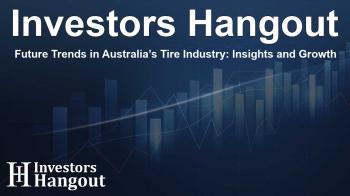Future Trends in Australia’s Tire Industry: Insights and Growth

Growth Trends in the Australia Tire Market
The Australia Tire market is on a transformative path, projected to expand significantly in the near future. Currently valued at approximately US$ 7.23 billion, it is expected to surge to US$ 10.94 billion in the upcoming years, indicating a robust growth rate driven by various factors influencing demand and supply.
Technological Innovations Driving Market Change
Technological advancements are reshaping the tire industry in Australia. For instance, Bridgestone and Michelin have both introduced innovative products that enhance performance and durability. Bridgestone’s sensor-equipped tires, utilized in mining operations, have successfully reduced unplanned downtime significantly. Meanwhile, Michelin's X Mine D2 tires have demonstrated increased service life, providing remarkable efficiency, especially in demanding sectors like iron ore mining.
Emerging Sustainability Trends
Sustainability plays a crucial role in the industry's evolution, with brands now integrating eco-friendly materials in their products. For example, Continental's Taraxagum tires—crafted from dandelion rubber—exemplify this trend, meeting regulatory requirements concerning environmental conservation. As consumers increasingly gravitate towards products that align with their values, brands that prioritize sustainability are likely to thrive.
Shifts in Consumer Preferences
Consumer preferences in the automotive sector are evolving, with a clear shift towards sustainability and innovation. A recent study shows a notable increase in buyers actively seeking eco-friendly tire options, with many now prioritizing brands that demonstrate a commitment to sustainable practices. Retailers are responding by offering bundled services that provide additional value for eco-conscious consumers, thereby enhancing market attractiveness.
The Rise of Electric Vehicles
The growing adoption of electric vehicles (EVs) in Australia is creating new demands for specialized tires that accommodate these vehicles' unique performance characteristics. For example, Tesla’s Model Y has surged in popularity, prompting local distributors to expand their inventory of EV-specific tires. This trend reflects a fundamental shift in market needs, requiring innovative solutions tailored to new vehicle technologies.
Challenges Facing the Market
Despite encouraging growth prospects, several challenges persist. High upfront costs associated with eco-friendly tires and varying regional infrastructure development remain significant barriers to widespread adoption. Consumers in price-sensitive markets may be deterred by the cost premium associated with sustainable options. Moreover, emerging competitors offering low-cost alternatives present ongoing challenges for domestic manufacturers.
Rural and Urban Market Disparities
The tire market in Australia also reveals urban-rural disparities regarding access to technology and purchasing options, affecting market dynamics. Urban consumers are more likely to embrace innovations such as online purchasing and digital fitting technologies. In contrast, rural markets may lag, presenting opportunities for businesses to enhance accessibility and service delivery in less connected areas.
Competitive Landscape and Market Dynamics
In response to competitive pressures, domestic manufacturers are adopting innovative strategies, such as automation and niche specialization. Investments in AI-driven manufacturing at facilities like Goodyear's Somerton plant have streamlined production, bolstering efficiency and cost competitiveness against imported brands.
Future Market Outlook
Looking ahead, the Australia Tire market is expected to thrive, fueled by continued consumer interest in sustainability, technological advancements, and innovative service delivery models. As market leaders adapt to demand changes, ongoing collaborations and strategic investments in R&D will play vital roles in defining the industry's future.
Frequently Asked Questions
What is the current value of the Australia Tire market?
The current value of the Australia Tire market is approximately US$ 7.23 billion, with projections indicating it could reach US$ 10.94 billion in the coming years.
How are sustainability trends influencing tire production?
Sustainability trends are encouraging manufacturers to incorporate eco-friendly materials into their tires, responding to consumer demand for environmentally responsible products.
What challenges does the tire market face?
The tire market faces challenges, including high costs of sustainable tires and disparities in regional access to technology and services.
How is the rise of electric vehicles impacting tire demand?
The rise of electric vehicles is creating demand for specialized tires that can accommodate their unique performance needs, prompting suppliers to expand their offerings.
What strategies are manufacturers adopting to stay competitive?
Manufacturers are investing in automation, digitalization, and niche specialization to enhance efficiency and competitiveness in the evolving tire market.
About The Author
Contact Kelly Martin privately here. Or send an email with ATTN: Kelly Martin as the subject to contact@investorshangout.com.
About Investors Hangout
Investors Hangout is a leading online stock forum for financial discussion and learning, offering a wide range of free tools and resources. It draws in traders of all levels, who exchange market knowledge, investigate trading tactics, and keep an eye on industry developments in real time. Featuring financial articles, stock message boards, quotes, charts, company profiles, and live news updates. Through cooperative learning and a wealth of informational resources, it helps users from novices creating their first portfolios to experts honing their techniques. Join Investors Hangout today: https://investorshangout.com/
The content of this article is based on factual, publicly available information and does not represent legal, financial, or investment advice. Investors Hangout does not offer financial advice, and the author is not a licensed financial advisor. Consult a qualified advisor before making any financial or investment decisions based on this article. This article should not be considered advice to purchase, sell, or hold any securities or other investments. If any of the material provided here is inaccurate, please contact us for corrections.

